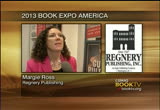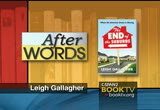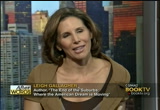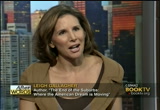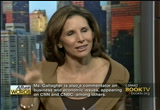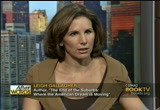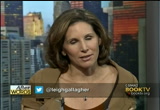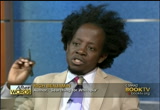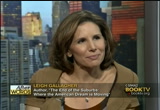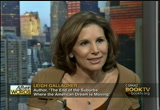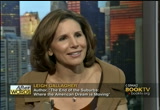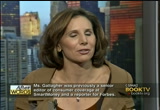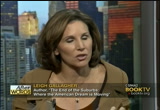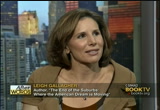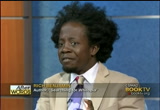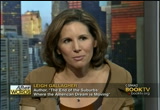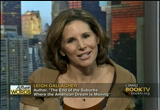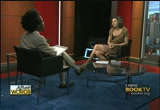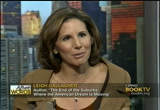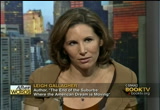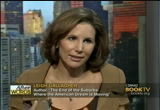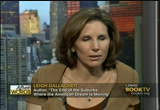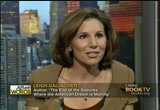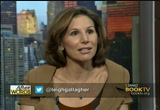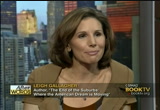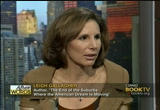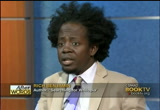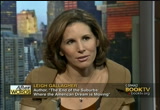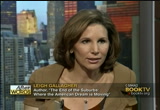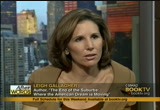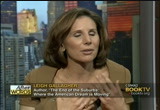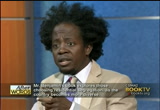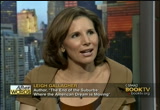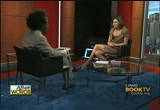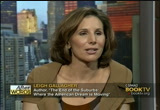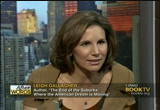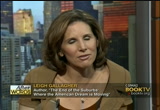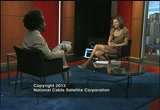tv Book TV After Words CSPAN August 11, 2013 9:00pm-10:01pm EDT
9:00 pm
9:01 pm
interested in the sort of angry red meat kind of rant and none of them fall into that category anymore. they are much more forward looking at what can we do to solve a problem, and they are in a lot of ways kind of optimistic box. >> ann colter, newt gingrich, some of the books coming out this fall by regnery. up next on book tv, "after words" with rich benjamin author of searching for whitopia. assistant managing editor leigh gallagher and her book "the end of the suburbs where the american dream is moving." she argues the recession and crash of the housing market have pushed more of the population to leave the suburbs and make a home inside the city limits. it's a migration she says is long lasting and good for society. the program is about one hour.
9:02 pm
>> hi leigh. you've written a fascinating book everybody lives somewhere. and you're telling us the end of the suburbs. can you tell us about the subtitle? >> guest: the main idea behind the book is that more than half a century of expansion into the suburbs coming to know, the suburbs are more than any other place sort of the cultural pillar of america to read it embodies the american dream, it's very -- the image of the house in suburbia is what people strive for and where people live but that is changing coming and it's changing pretty dramatically. these changes have been slowly over time that every indicator you look at is showing this. we are tired of this way of life and the reasons behind that are numerous and complex and kind of
9:03 pm
draining away for a number of years. the debt indicators out there, the sort of sense of the american people who live in the suburbs were really looking at a sort of seismic change in how and where we live and i just thought that was a really momentous trend and one with delving into and so i did. >> host: i will be interested to hear about those indicators. but first i wanted to know what inspired you to write this book to look at this? >> guest: i kind of caught west about the headlines of the census data showing sort of whiffs of the speculative on to the radar and i thought this interesting. there could be something bigger. so i started looking into it and was sort of the case where every stone i turned over yielded some other fresh demonstrative proof that something was changing in
9:04 pm
our housing preferences for changing and our migratory patterns are changing, that our demographics were changing. every aspect i looked at, everything was moving away from the conventional serbia and the words not just cities, and we can talk about that a little later but there was a huge movement happening and i am fascinated by this for the societal trends that really shape how and where we left, trends that sort of kind of hit us through the zeitgeist. i'm interested in those trends in the economic data and here i have a one to punch. i have a topic that is all consuming and affects everyone. so i decided to double down and research and write a book about. >> host: we will hear about the trend but everybody has a relationship either by consuming and through the popular media for having lived it themselves
9:05 pm
or a relative that lives there. so you talk about a shift. tell us about the old normal and then about to the new normal. >> host: >> guest: what's interesting is everywhere i went they want to talk about the topic. i would go to the cocktail parties and i couldn't seascape because every but the is interested in this topic whether you live in the suburbs, you have to grow up there, you know somebody that did, if you didn't mean to you are curious about that or have the opposite experience. everyone is super interested in it. and so, you know, one of the things i encountered was a lot of people that grew up in the 70's or earlier had a tremendous amount of nostalgia for the suburbs they grew up in and one of the things i document in the look is how the suburbs of yesterday look nothing like the suburbs of today. and a lot of that there are many reasons, zoning changes, mass production being invented and taking over in the 1950's. but if you think about some of
9:06 pm
the older suburbs, a lot of the suburbs in the northeast or other places around the country i would say before world war ii they tended to grow up around the railroad stations or st. car station space those suburbs were built before the car so they kind of spread it organically usually there was a nucleus for the public transportation dropped to rebut the off and then the shocks and maybe there were apartments they sprouted out that center because there was no car at the time all of the houses had to be built relatively within walking distance to that town so starting after in the 1930's there was a new type of zoning that came to be, and i go into it in great detail in the book about what that did is it broke everything apart and basically mandated that all of the stories were going to be over here from all the houses were going to be over here, the industries were going to be over year and even
9:07 pm
the medical places would be over here and we sort of spread everything apart and by that time of course the car is how everyone was getting around everywhere and so it set up a lifestyle where it had to kind of go from one place to the other to the other and so that is the sort of modern-day suburbia but as the default, the distances between those points a grew longer and farther and farther apart. so, you know, there is many years between then and now but during that interim we kind of over expanded, build houses far apart from the cities, far apart from each other very far from the cities. the traditional definition of the suburb is a residential community outside of the city. many suburbs are hours away from cities now so they just sort of overshot their mandate. host could take a community like new york city where we are. the suburbs like yonkers or
9:08 pm
westchester, and then you go farther and farther to the outer suburbs which can be as far as bucks county pennsylvania were way up state. and so this trend has made us moved farther out into the exurbs come is that fair? >> guest: and that was happening anyway. but then you had this housing boom that started in the 90's and then in 2000, peaking in 2005, 2006 that the whole operation on steroids so what was considered a exurbs 15 years ago are now probably considered conventional suburbs because during the housing boom of you had people that what communicate there was a sort of media aren't getting the biggest house to goodbye or the nicest house you could buy and the lending standards were so liberal that you could get a loan for almost nothing. because of the sort of built in
9:09 pm
wiring of the american dream, people really wanted that. they wanted to get these loans and put themselves in the best house the cut, and oftentimes that meant going the further out because the bigger house you can get. it's plain economics. so there was a coinage for that behavior called dr. to qualify. so you can't get the house in the suburbs that's big and beautiful but the one away you can really get that and it's not so bad. we will deal with it. it will be fine. but i go in and commuting as a whole other topics i spent time on in the book but three and a half million in the country now to commute 90 minutes each way today. >> host: you quote inexpert that has a fascinating statement who says this brawl demon is dead. tell us what you found about the mansions in this whole phenomenon.
9:10 pm
>> guest: there are two camps of thought when it comes to small and is it totally dead or just quieted down because the housing bias and is it really going to come down when the market gets back which it is starting to. the housing market is starting to come back read this is a field of social experiment. this didn't work for many reasons. they are totally legitimate. when you look at the demographic trends and the nature of the american family, there is a case to be made for the next boom and expand its going to look a lot different. but this sprawl that said the it is dead is a former engineer and he spent many years basically building sprawl. he put in place the infrastructure that - yours and pipes and everything to suburbia. it costs a lot of money and a lot of resources to build a
9:11 pm
suburbia. and his major point is that the suburbs are financially unproductive. he thinks that they're basically a ponzi scheme because it costs so much money to build out of that infrastructure that the tax revenue than you get from the low density of arrangement of single-family houses isn't going to come close to paying for all that so they will get these big grants to fund the project of building the pipes and everything which is hundreds of millions of dollars and and they get more and more tax revenue coming in. so that is his take on things. he really thinks we need to build communities that are more financially productive so there is an ankle to help the suburbs are built in the other ingalls i go into that support the argument as to why they are not built in the smartest way. >> host: one of the elements i love about this book is that it's very carefully and it's very thorough. you describe them as they once
9:12 pm
were. people who move further and further out into the master plan subdivisions and you say that is really dead in the urbanized suburbs. tell us what that means and take us through the demographic phenomenon that explain why this is happening to us. >> host: when you are going to say the suburbs are dead and dying that's true. i stand by that. it's absolutely true. but the places that are going to do well -- it doesn't necessarily mean everyone is going to rush out and live in a skyscraper in new york city. that is just ludicrous in itself because a lot of people don't want to live that we either. so a lot of people in the country say over my dead body and my going to live in the city. but everybody wants to sort of be closer to the things that they do every day and closer to the people they want to see and
9:13 pm
spend less time in their cars and just be less isolated. that is what is driving a lot of this a one of the things you are seeing is builders and developers and planners falling all over themselves to build these urban burbs and i hold this up as a paradigm in the book and many are built on the old suburb that we sort of forgot about, the one before. but urban burbs, they are everything. some of them are the sort of older suburbs that have remained untouched in it in the northeast you tend to have a lot of those and places like montclair new jersey is a great example that has a classic town center. it's a village. any place that has that kind of philip organically, they are going to do okay. what's happening as the builders are trying to build, you know, the new suburbs that have some of these characteristics and the take many different forms. some of them are literally high
9:14 pm
rises in the middle of suburbia with a couple stores down below as a people can walk to the rest of and everything. some of them are brand new communities that they are built on these older traditional planning principles so they are meant to replicate. in the book i spent a lot of time that one community in gaithersburg maryland and this community is a new urbanist community that is a sort of saw the set of the ruben universe and they've been lobbying this for years and now they see the moment because the big builders are trying to do what they've been doing and crying for all along. but this community is really fascinating because it is far away about 30 miles from d.c. and you drive to get there and you drive past this conventional suburban strip mall place and then you make a left turn and enter into this community and all of a sudden it's these
9:15 pm
narrow streets and a center with the sidewalk cafes and the houses are federal town houses adjacent to each other near the town and then they get a little further apart as you go away. it's almost like an older community was cut and paste it into the middle of suburbia and it almost feels like georgetown or park slope was literally dropped in the middle of suburbia. >> host: i've actually been there because my parents and my brother live near gaithersburg so we talked about this with the town center, with the proximity of mismatched housing. it's fascinating the way you describe it and i mention them because a lot of your research is census driven but you also have poignant story telling of people you've met, and for me one of the most memorable moments is when you speak of a woman who fought she wanted the
9:16 pm
dream and the suburbs but she moved there and felt isolated. so tell us about the people you meant and what for some of the most memorable moments of people you met? >> guest: she was one for sure. she had three young to children at a time, she and her husband wanted the american dream and live in suburbia and fought let's try it. i want to do this and this was outside of boston. she thought if we are going to spend this much money at the time it was the housing boom so it was 300 or more for a house, we want it to be a nice house so they went a little further and they started looking at the cluster suburbs outside of boston that they were too expensive. they went a little further out and the and that getting the colonial kind of looping the subdivision and they thought it was all going to be great and they were really disappointed with the quality of their lifestyle. a lot things about the way they left their days for different
9:17 pm
than they expected, and i think one of the things for this woman is that she didn't realize what time she would be spending in her car. i found this over and over again many people that moved the suburbs think that they are going to have this life like they had in the suburbs you open the door, the kids run out three hours after school, they all play together and then you call them in for dinner. that doesn't happen anymore. i mean it does in some places and that is because we are in and played a culture where everything is scheduled to begin this isn't necessarily just the suburbs. this happens appearance in new york city do this also. it's more of a lifestyle, the dual parent working households and there is a number of reason for going into it this mother of three from 3 p.m. to 6 p.m. every day she would put 40 to 50 miles per day driving her kids to the soccer practice and the hebrew lessons and the sand
9:18 pm
that and that they had to go to. she was the inspiration for one of the chapters that is a quote called my car knows the way to gymnastics and that is what she did every day. she also found it sort of isolating. she didn't like that the community was very -- it wasn't diverse even then just people's ages they were between the age of 30 and 50 and raising young children. and a lot of people would say that when you live in a city or in more older suburb and one thing of the really lobby for is this diversity of age group. maybe what a mixture of people, you want older people and a number of people and everything in between that makes for a vibrant community rather than everyone having a single mission and a single purpose which is raising their kids which there is nothing wrong with that but they seek more of a mixture. >> host: with this age homogeny eddy and the long commutes and the ponzi scheme of
9:19 pm
the financial unattainable the, what other complaints did you find about a suburb talking to people around the country? >> guest: it's interesting. the commute is a big part of it. one of the interesting stories i found is i talked to a woman that lived in orange county in california and she and her husband moved -- they wanted to move to the inland empire and it's where a lot of the housing expansion happened during the housing boom so they found a great house and the intended to also find work there but they couldn't because the job market wasn't good so they set off for a year and said we will keep our jobs and orange county and commute every day. it's no big deal. they did this and it's a terrible commit the would set their alarms for 10:04 in the morning, leave at 10:15 and then the committee would be one hour and 15 minutes. every other time would be the
9:20 pm
would be so early for their jobs they would park their car in the mcdonald's parking lot, decline their seat and taken out and they would car pulled together which is rare. on the days she had to come and let herself she didn't want to sleep in the mcdonald's parking lot by herself so she would go to her classroom. she was a teacher. she would sleep under her desk and as she said to me i felt like george castaneda which is a famous seinfeld episode where george takes a nap under his desk when he's working for the yankees. she would bring her flat iron and get ready for her job in the bathroom. the commute home was worse. she would spend two or three hours in the car and pulled herself in her bed to the crème decram effros 30 minutes. but she quit her job before finding another one. she says i can't do this.
9:21 pm
this is the soul sucking. it's not good. and they did find jobs but in the interim, she left her very good teaching job for which she had gone to graduate school and she started to doing for eight or $10 then from the was different than doing this commute from any longer. >> host: you said that is the sort of downside of the suburbs and in this book to declare the end of the suburbs you said you personally are not against the suburbs. you have nothing against the suburbs. tell us about the defensiveness that you encounter. >> host: it's funny. i didn't want to -- i am not some sort of antisuburb person who thinks that everyone needs to live and who york city. i was very sensitive to come across as a sort of espressos upping. that isn't why i did this book. dalia understand why people like the suburbs.
9:22 pm
i get fed up with a lot of daily life in new york city. i was more drawn the transfer so undeniable and fact there is a shift in the way that suburban america is received is to begin a story to ignore. so, you know, i had a wonderful experience growing up in suburbia. i write a lot about it. it's this adorable tom, pre-war to be to pass these ingredients you don't see any more. it has reached ought and a courthouse, a lively man st. come all these events. we could walk to the town from my neighborhood. there was a great annual fourth of july picnic but that is the kind of suburb people are nostalgic for and that doesn't drive with the way people are today. one of the interesting statistics i can crosses the average age of the stock is
9:23 pm
1974. which is pretty new. you think about older communities being charming but most of the people don't live in those communities and new housing. with those houses are built differently and they look and feel differently. i was just very maybe not defensive but i just wanted to put out there that i had a wonderful experience and i can see why a lot of people want to live there but i'm telling you this is changing. >> host: people are perceiving the changes but before we talk about the changes a lot to ask do you watch house and garden on television? >> guest: sometimes. >> host: i don't own a television but sometimes when i sneak away i will watch these shows and i'm curious what you think as a housing expert would you think is behind that? is the booming popularity of the house hunting shows flip my house, find my house what's
9:24 pm
going on there? >> guest: they are different pockets. i think flip my house that is a product of the bubble where everyone felt they could become a millionaire from buying the right house and flooding it so that time is over. when the housing market comes back it isn't going to come back like that. so that is one aspect of it. but there is an obsession with a fantasy house and building it or improving it or making it better and it's okay to like where you live and what your house to be the nicest it can be or even your apartment. i want my apartment to be nice and queued on the inside so i care about what goes in it and fixing it up and everything but if you look at the trend of how we are fixing the powerhouses and what we care about, those are changing, too. the average size is going down although the data doesn't show that because for all why all the
9:25 pm
wealthy people were bawdyhouses but living rooms and dining rooms i had one person in the book of basically said the living room as an endangered species. the way we live in our houses is changing and the shows reflect that. everyone wants the great room now, an open kitchen. you see more interest in the efficiency you have less space that you lose more of it. think about in my house growing up we hardly ever used the dining room, we used on holidays but even then we would set up the place and went to the living room. my mother started a business once and caulkett drt productions, dining room table productions. that is how they are incredibly responsive to this. the design what we want like this and so if you look at the homes that are being designed and built today they make more
9:26 pm
efficient use of space. >> host: and the space is an outer reflection of our inner beings and needs as families and individuals so to write my book i post as a home by air to see where people are living and to talk about space, elders base, built space and it's fascinating that is one trend to point out is you are living generally in smaller houses as defined by square footage than we were even ten or 20 years ago. >> guest: that's true. the trend in home size has been expanding since the 50's. the average was 900 some square feet. let's imagine that now. i can imagine that. i live in a little apartment so that is big for me. but it's starting to shift. you look at other things that are starting to show up in the houses and for a long time, you know, everybody was in to having
9:27 pm
a deck in the house and that is a big part of the move that is how a long time ago air-conditioning sent us all inside when devotee started having air-conditioning you didn't need to hang out on the porch anymore and then it can about the backyard and the grill and everything and that was the focus of entertaining everything that you are starting to see porches come back into the home design and they are important because there is a social element to them. they draw people out in the houses and communities have porches they communicate with each other more although the way they have to sort of be close together for that to happen. the way they are spread apart now that doesn't happen in a lot of communities. there was one person who said in a story, and he said in the book i know more about the person i sat next to on the plane i just took and the person i live next to for five years. >> host: it's fascinating in the way people have become the pseudo food experts because of
9:28 pm
the food network and we've become conscious of space and design than we were let's say a generation ago. before going to break, one fascinating and devastating quote is to quote an expert to use to work at the cdc who says it is almost as if the suburbs were built to meet america and healthy. what did he mean plaques tell us about that >> guest: the way the modern suburbs were designed with the subdivisions and very friendly to the car, a very inhospitable frequently to pedestrians. anybody that wants to locker. it is the modern suburbs and the older suburbs and they have the side walk into the narrow street. the new suburbs don't. so people don't walk. they don't walk even when they can. they organize an effort to walk to school.
9:29 pm
what jackson was saying he spent a lot of time researching this he said it's not good for our health. spending all this time in the cars if you are the child, children are kind of being raised in cars because they get driven around everywhere and there is a consequence to that. children don't walk to school as much as they used to or ride their bikes. they aren't really active. when you are not using you're 2 feet to transport yourself at all it does take a toll on your health. walking is important for a number of reasons and i spent some time getting into how the body functions when you are walking regularly in the book. but this is why he thinks this is why we have so many escalated
9:30 pm
levels of diabetes, heart disease and white children are seeing these that were once limited to adults he thinks our velte environment has a huge amount to do with our health problems in this country and he marshals a lot of the data to show that and, you know, it's kind of logical if you are in the car and not walking you're going to put on some weight and to spend three hours commuting that might go into your jim time. >> host: your site diabetes, heart disease but i also remember him siding depression. >> guest: there is data on this especially young children. you know, the sort of clich being boring for teenagers there's not much to do is isolate and until you have your driver's license and been you are relying on your parents to drive to around at the moment you need to kind of separate and a lot of -- there is a lot of
9:31 pm
people in the psychology field that have studied this and then the among the adults, too. they lived to the suburbs and find it more than they would have expected. this isn't to say there are not life communities. there are many communities and many cul-de-sacs in of the environment. that's true but many people were also surprised at how isolating the lifestyle is because you are attached to your car all the time and you are driving everywhere and there is no sort of serendipitous encounter on the streets when people aren't walking so this is the kind of thing people want more of and the builders are trying to provide for people.
9:32 pm
>> host: as we know the country has experienced a housing bust and you can drive to certain communities where whole subdivisions seem to look abandoned. talk about the housing bust and when you discovered. >> guest: we have these subdivisions that are built in many cases purely because of the housing boom were all the loans were artificially inflated and so the subdivisions were built further and further away and so many people lost their homes and now many of them are empty. the overall housing inventory problem is better now than it used to be during the height as we are recovering and you can
9:33 pm
still get a great deal of the house if you want one. >> host: what is the effect of all this overstock and what should we do with these abandoned houses and overstock in the communities? >> guest: that is a good question. what is meant to happen when housing rebounds cracks are they gone for good and will there be a demand for them? there is a case to be made that there isn't could be the kind of demand for those houses and those locations ever again. and so, a lot of academics and economists have come up with a lot of ideas on what to do with those houses. one push right now is to try to facilitate the log the combining of them who want to rent them out and turn them into rentals so there is a big effort and there's been to the economic opportunity for those kind of big institutional landlords the communities are going to look that way because when you have people that own the houses they take better care of them said that present some questions and
9:34 pm
also are there enough people to populate them when they are located so far away from the corps centers for most people want to live. the other thing people have suggested is maybe they will be turned into subdivide these houses, and again, turn them into communities that are almost like each house becomes a place with four different apartments or something like that. but the problem is nobody is allowed that. and the houses were not really dealt to last the way older houses were so the well deteriorated at some point anyway. so nobody really knows what's going to happen. there are a lot of people that think they will be the slums of tomorrow and that would be an interesting reversal because it wasn't so long ago the city's worst slums and there was a time in the 1800's when you said the cities were going to be slums nobody would have believed you because the would be thriving centers of culture and then what
9:35 pm
look at what happened in the 1970's. everybody exited and went to the suburbs. the cities were destitute and now that could reverse. >> host: there are some home builders and realtors. so it is a fascinating dynamic to see whether in fact it's going to become this utterly permanently abandoned zombi community or whether people will draw a stake in the ground and revives once the economy picks up better. >> guest: but if you look the demographics they are a huge part of this conversation. if you look at the birth rate going down, what we have come to think of as the american family, a couple with two young children that has historically been the predominant driver of suburbia, that family unit is totally shrinking in a big way. so you have to think they were built for basically families. they were not built for single
9:36 pm
people living alone which is one of the fastest-growing household types and they were not built for people with no children. the demographics around children in the country and the birth rate are striking and as a result you have suburbs that aging. statistically speaking in the suburbs than families with young children. this is a huge part of the story and in my book i talk about my father who grew up in a community called drexel hill populated with tons of kids and on his block alone, the 900 block she counted there were 41 children on that block when he was growing up and now i hired a private investigator to try to get me a number of how many kids are there now and there's less than 15. that change is happening all over the place and that is going to fuel the imbalance that means we have we too much of one type of house and not enough of another.
9:37 pm
and the kind of houses that are kind of in the subdivisions and regular so divisions. if you're point is that many of them still believe that there is a market for the conventional suburbia. they might be right but it's 20 a dramatically reduced market. i spoke with the ceo for the buck and he said he used the word mothball. we have mothballed some of our communities and that means they are not building more. they don't open a community unless it is sold. but the counter intuitive indicator that i found is that they are going like gangbusters. the half 30 buildings here. they are expanding to other cities and to sell paulo. they are going completely urban. this isn't the majority of but it's the fastest growing and one of the brightest spots.
9:38 pm
the condo buildings, 20 million-dollar penthouses. stuff that ten or 15 years ago you thought you would never see. >> host: the notice as we speak detroit is going bust so the first part of the question is what cities are having the renaissance that you are talking about and why do you think that is and then what cities are not? >> guest: it is a tale of two cities and the beach right story is separate. it's lost that the cities, economies and the fiscal health are often times to different things. you look at new york city and it is thriving by any definition. if you look at neighborhoods like the meatpacking district in the 70's and 80's he wouldn't be caught dead and now it looks like a casting call for the bachelor that it looks like bald up 20 some things on the
9:39 pm
weekend. it's the place to be and that never would have happened so new york this kind of like an amusement park for the economy is doing very well that majorca's fiscal problems, too. many of the same problems detroit had so those are two different things. detroit is some of the rust belt cities are adjusting to a massive shift in the economy from an industrial base the economy or service based economy. there's a number of other things happening there as well but not all cities are research and in the way that new york is but many are. i think places like detroit and buffalo and others are the minority. over all the story about a cities right now is that more people are staying in them and more people with families, young couples with families. >> host: seattle is thriving in the booming, bamberger is thriving and booming, chicago is thriving and booming.
9:40 pm
what do these places have in common? >> guest: it's living in the city and raising kids in the city is an option now where it didn't used to be and if that is a number of reasons i talk about in the book. it's the same thing driving away from serbia. rising gas prices come people having fewer children, wanting more sense of liveliness in their communities, schools improving in the cities. the schools are still big issues in the nevado people to the suburbs but that is starting to change, so and cities are different. a city like seattle or st. wallsten it's easy to have a suburban lifestyle in those cities you can have a single-family detached house and still be in the city and in fact you are living in a kind of dense -- usually those neighborhoods are denser and they have those kind of characteristics that people are looking for in the suburbs but they're finding them in the
9:41 pm
city. >> host: you outlined a generational trend of the suburbs, the taste of millennials particularly the consumer tastes. are there any racial dynamics to that, you point out where where and why people move or to the appeal of certain places? >> guest: it's interesting, race there's a lot of racial inequities in the housing market. the rate is 65%. that is the average home ownership rate. for white it is almost 74% and african-american it is 40 some percent and a lot of this goes way back to when our kind of federal policies that supported the housing market were put in place we back after the depression you had the fha and the original government-backed loans put in place to jump-start the housing market it did that
9:42 pm
in the 30's and then in the 40's and 50's there was a process whereby neighborhoods were coded red, blue, yellow or green and most of the communities were coded red and those communities didn't get -- the fha wouldn't back loans to these communities said it was factoring in the diocese of the day and those are gone now. but there are tremendous racial inequities in the housing market and also i mean, it's just the suburbs and the exploded in the 50's and 60's they were primarily white and that's changed a lot. the suburbs have changed so much a mirror america and there are some firms every type of shape and flavor, wealthy come every type of class and race they really do resemble america much
9:43 pm
more than they did in the 50's and 60's when they were born and even in the 70's. so that's a little different. but people like to be around people like themselves and you see them all over the place, you see that in new york city. they are pricing out anybody but bankers so maybe it isn't so diverse anymore. i say it's the land of 25 charles with $2,500 handbags. >> host: i took about this transition and they told them the firm or her suburban mostly real estate developers now are going into the cities because they see the money to be made and these luxury condos look and in fact cost a fortune to and so also that racial fault but also the objectification. you talk a lot about that. >> guest: gender occasion is what brings the money to the cities and everything but also
9:44 pm
pushes a lot of people out and it's what has made new york and affordable for a lot of people. >> host: yeah. and so tell us about the millennials. let's talk about the levels. how are they going to change how we live and where we live? >> guest: they are poked and prodded. there is a study about literally everything they do. i found one study that said millennial moms use their phone more in the bathroom than on millennial bonds. it's just kind of crazy but they are really important because they are a huge population. the year bigger than the baby boomers and what they're going to do is going to determine a lot about the future of the housing market. right now as it has been documented a lot of them are still living at home and of having a failure to launch a situation and that this may be an overstatement but it's true, statistically speaking more people of that age group in their early 20s are living at home still than any time since the 1940's and that is because of the job market and a number
9:45 pm
of other things but when they launch of the studies show they will not want to launch into the suburbs, they aren't getting drivers' licenses anywhere near the case that maybe you and i did when we turned 16. they want to be where everything is nearby yet they can walk everywhere and that doesn't always mean the city. they like the walking suburbs but there are not enough of those places so that this kind of for the supply and demand come san. there's just not a lot in those communities that a lot of them grew up in the exurbs at this point and they know what it's like to drive 20 miles to get a gallon of milk or ten or five to is still a lot. they don't want to do that and don't forget there also attached to their devices. you can't text and you are in the car. you shouldn't but you also can't be doing all of the social networking when you are driving and so they are huge users of
9:46 pm
public transportation. they don't want any part of that. at this is maybe what stereotype but it's true it's been studied. some people say wait until they have kids. as of all time low for the age group and there is a reason to believe they will not come back to the cul-de-sac even when they have kids. it creates an incredible and balance we have all these places the were built in one way, and all these people coming out what a different kind of house and a different kind of place and so there is a tremendous -- one expert i quoted in the book has a supply millions and millions of single family large walled houses. what's great be done with that and because of the baby boomers that are living with them now the natural time to adjourn the
9:47 pm
house is over wins this generation isn't going to want to move into them so as much of an imbalance we have now, it's going to get worse. >> host: you are and editor for fortune. just between you and i, let's be real it in terms of financial value bang for the dhaka and quality-of-life, if you could live, where would you recommend folks moved getting all this research you've done and all these places you have seen, given your understanding of the market, tell us where would you live? >> guest: not the city coming you said. so an urban burba and they take many shapes and sizes depending on the market and the geographical area. there are many of them you mentioned in the book i can kind of open up some sort of consulting service and tell people where to live. >> host: you say i hate to pay you for your expertise.
9:48 pm
>> guest: around new york the suburbs that have any kind of organic old village. so i mentioned on clear, scarsdale. all of the western suburbs, most of them have that kind of a village because they were older suburbs. there's an interesting coalition between the age and liveliness. people studied this and found that. the work i would go to a place where there is a town center that is interesting and a place you want to be and that place is within a couple of miles where you live. you don't have to begin to walk from your house to that place but that place should be am i or to and not ten or 15 so that everything. it's no longer location, location. its access. that's what people want. >> host: access to what? >> guest: access to different people, to commerce, to a town
9:49 pm
center come to in the end they will save you time. everybody says the one thing money can't buy es time so let's take away the 45 minutes to spend in your car, give them back to you and put you somewhere where everything you need maybe not your job but everything you need is within a couple miles of where you live to the interest of there was one place like that in colorado. tell us about that place. >> guest: this is an interesting example of what people are doing what dollying malls. what's happening to the big july and suburban shopping malls which for such an institution on the east. people don't want to shop that way anymore and a lot of them are detaining can't do anything for them. it's hard to -- you can't just raise them. they are massive expense of complexes so there's a movement to turn them into villages and one of the neighborhoods is having been colorado the trend
9:50 pm
this abandoned shopping mall into a pedestrian community with 1100 houses and a whole problem on with stores and retail and cafes and restaurants and an ice skating rink and a movie theater. they've turned it into this really community where a lot of people have moved and so that is an extreme example. i don't know that everyone wants to live that way but it accomplishes different things which puts that space to use and a community where people can be walking more and have a sort of urbanized lifestyle in the suburbs. >> host: you tell us where physically the future is moving. but tell us where you think the american dream is moving. and i think from my thinking that is the provocation of this book is that it's very provocative and fascinating. you declare the end of the suburbs because there is such a link in our thinking between the suburbs and the american dream
9:51 pm
as you said so let's think first about what you think future of the american dream is. >> guest: it is totally in flux. is the dream going to be a sort of lifestyle? who says it has to be a structure? we did that to ourselves. the original who wrote the american dream it wasn't to be a house. we just we were so fascinated with the house and the notion of suburbia that the time that it sort of fused on to me in a life of a house and a picket fence and all that and so it's changing. is the american dream going to be a condo in a high-rise? i don't see that happening necessarily. but i think it is granted the lifestyle where there's more community. i use this word so much in the book but slightly less. it isn't necessarily just about the house itself it's what you do with your day and the people you surround yourself with and i
9:52 pm
think that's coming to play a role where people choose to live so it might just be a smaller house in a community that has sidewalks and that's not too far from a little village center. that's not so different but it's completely different from the way people have been living. >> host: a fascinating thought. the american dream doesn't necessarily have to have a structure. but what this poignant for me is that they did a study and a lot of young people think that they wouldn't have fit better off than their parents did. so, if one believes that the american dream means doing better than your parents did come in that sense the american dream is on a decline but it's fascinating in the book the way that you say the american dream is in the suburbs but it can be this and this and it's a very persuasive to waive a you leave that out.
9:53 pm
>> guest: you made a very important point which is the suburbs blossomed at the time our economy was booming, when the middle class was booming and there was hoping never to be as far as the eye could see. and we are living in a very different time right now. i'm optimistic about the economy. we are in a recovery that the declining middle class is a huge trend and that plays a role. the middle class is the engine that grew the suburbs and so, you know, that is going to show what in our housing market in the way we kind of a range our landscape in the future so that is a huge part. you don't want to say maybe there is an american dream anymore because we don't have any hope -- i don't believe that. but it's -- it certainly doesn't hold the place in the psyche that it used to. >> guest: >> host: i don't believe that either that the to field their prospects on the decline. we will see. the book is very well and
9:54 pm
lightly. tell us what you enjoy writing about. >> guest: i really loved writing this book. i like talking to people and sharing their experiences in the suburbs and what they like and didn't like about it. i like to building my own experience into it and traced the narrative of the country through the suburbs which, you know, it just it really tells the story naturally, so i like that and i like all the individual people here and hearing the crazy stories about how people live and about how some people love the suburbs and some people hate them and i encounter a wide variety of e du plants bigot i talked to one woman who lived in the community the houses were built so far apart on halloween they didn't want their kids to trecker treat because it exhausted them. they would get tired, they wouldn't get any candy and they thought it wasn't safe so all of the parents decided to go to the
9:55 pm
school and park their cars and the kids would trigger retreat from car to car. some people hear that story and think it sums are fighting. some people are like that's great. let's decorate our cars and, you know, we will do it but they were creating this community because they lived too far apart to have it organically. but this woman was interesting because she said you know i don't need to walk anywhere. i have five kids. if i could walk to the courage restore you think i'm going to walk back with all these chris reese? people have a lot to say about this and that was my favorite part is hearing people talk about your own experience and see how that fit into the trend. >> host: how long did it take to write the book? >> guest: i did about a year and a half of research and maybe a year and a half of writing. i could have spent more time on it. i went down so many ruffles it's just fun. there is such history. it's true what people say about
9:56 pm
authors. you can see how people spend years on a bookend finish. >> host: cingular a writer and editor and that is reflected in the book because it is balanced and so this is what is happening and i am just presenting it said that's the book. but just between you and i cannot tell us honestly. you talk about prefab isolated divisions and represent the information buck -- book but are you glad that isn't something in the past? >> guest: i am glad some of that is a thing of the past. ibm. the way we build our communities were on healthy and unsustainable and in hospitable to the relationships and not good. people fought there was a wonder and a duty to that and they felt that they were selling a false bill of goods and if they didn't, you know, it's very hard to find people who love
9:57 pm
everything about suburbia. on atwitter i looked and i found so many people that found the suburbs that i found one person on all of twitter that said i love the suburbs. so, some of it is good riddance. i will say that here and now with you. absolutely. >> guest: >> host: beginning to conclude, what were you most surprised to learn and what you think the readers will be the most surprised to learn reading this book? >> guest: i was surprised to learn just how stark the changes are that's happening. because three years a lot of people have said the suburbs are bad. they are homogenous, they are boring. you don't have to go very far to find people to come into the suburbs. this is the first time i was surprised by the amount of data that was really supporting this argument and by the movement on
9:58 pm
the behalf of the home builders to find a solution. there is so much happening right now in the home building community how to build houses we want to play with -- live with and i was surprised by that because i started with a couple of the plans i saw. i had no idea that it was happening. the more i looked, the more i found. a study after study shows the most interesting things. you know, and it all comes back to the sort of older communities built on different kind of stones being better, better for our health and happiness and relationships [chanting] our wallets and everything. so that is what was surprising to me. >> host: fantastic. thank you for the time. >> guest: thank you for having me. it's been a delight.
9:59 pm
>> that was "after words" book tv signature program leche authors of the latest nonfiction books are interviewed by journalists, public policy and others familiar with their material. "after words" ears every weekend at 10 p.m. on saturday, 12 p.m. and 9 p.m. on sunday and 12 a.m. on monday. you can also watch online. go to booktv.org and click on "after words" in the book tv series and topics list on the upper right side of the page.
71 Views
IN COLLECTIONS
CSPAN2 Television Archive
Television Archive  Television Archive News Search Service
Television Archive News Search Service 
Uploaded by TV Archive on

 Live Music Archive
Live Music Archive Librivox Free Audio
Librivox Free Audio Metropolitan Museum
Metropolitan Museum Cleveland Museum of Art
Cleveland Museum of Art Internet Arcade
Internet Arcade Console Living Room
Console Living Room Books to Borrow
Books to Borrow Open Library
Open Library TV News
TV News Understanding 9/11
Understanding 9/11